How to Smoke a Turkey: Temps You Need
If you’re looking for a way to make your holiday dinner more exciting this year, try smoking a turkey! Celebrate with a turkey that is full of flavor and fun. With our thermal tips you can be sure that you’ll get a delicious, safe-to-eat turkey unlike any you’ve served before.
Making a smoked turkey can be daunting because it’s such a large, strangely-shaped object with so many things going on—a rack of ribs is the model on simplicity in comparison—so it is understandable that many people have never tried it out. But that size and complexity needn’t worry you. In reality, it’s as easy—or even easier—to smoke a turkey as it is a pork butt. One of the main differences being that we only want to cook a turkey to a pull temp of 157°F (69°C). Turkey breast is naturally tender and low in connective tissue, and will toughen and dry out if it cooked too high, as we’ve all tasted before. (It is true, however, that the dark meat in the turkey back, thighs, and legs does have connective tissue. For more on this topic, read our post, White Meat vs. Dark Meat Turkey Cooking Methods.)
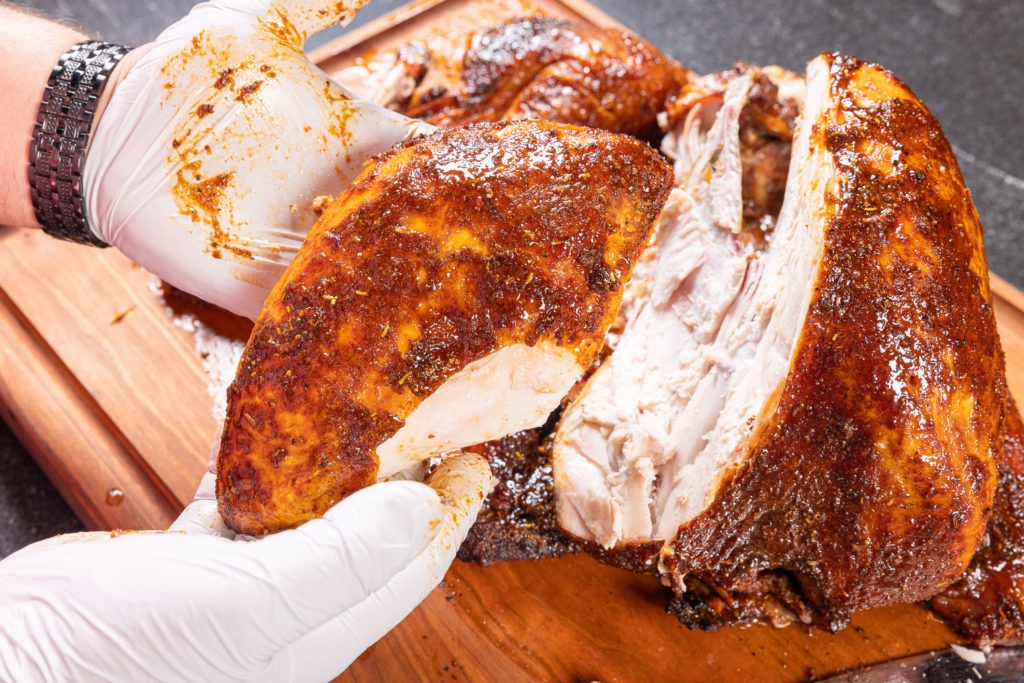
To make sure our smoked turkey comes out juicy, we need to make sure we’re only cooking it to our target pull temperature and not any farther. To do that, we need to make sure we’re placing our thermometer probe correctly. Place the probe in the thickest part of the breast, in the center of the meat. This is the coldest part of the bird; when it reaches our pull temp we know the rest of the bird should be good too.
With all of this in mind, let’s smoke a turkey!
Tools for smoking a turkey:
Smoking a Turkey
Seasoning the bird
You can season the bird however you like, whether with an herby compound butter under the skin, or with a BBQ rub of your choice. We opted for the rub this time, but we chose one with lots of herbs in it. We oiled the skin (mayo also works!) and liberally applied the rub.
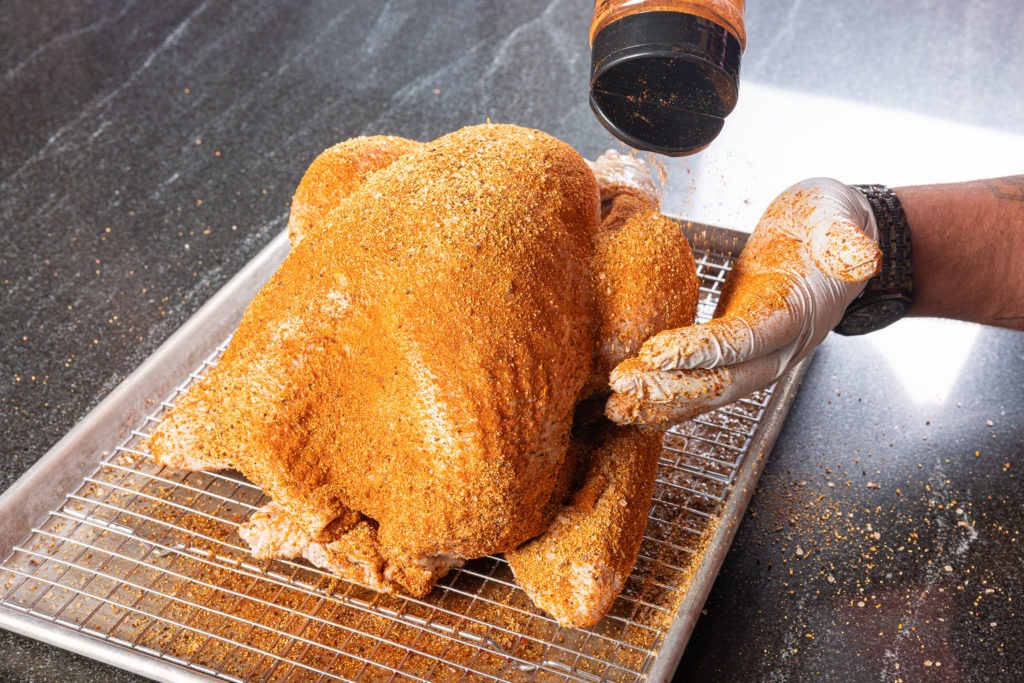
(If you decide to go with a compound butter, prepare it by softening a stick of butter then mincing herbs—sage, rosemary, and thyme, for instance—and kneading them together with the butter and some ground black pepper. Then separate the skin of the turkey from each breast with your fingers and hand. Stuff one-third of the compound butter under the skin of each breast, smoothing it down under the skin to cover as much meat as possible. Melt the remaining herb butter and pour it over the top of the turkey breast. Rub it into the skin with your hands to coat the turkey.)
Prep your smoker
Clip the Pro-Series High Temp Air Probe With Grate Clip in your smoker and preheat it to 275°F (135°C). Choose your favorite wood or pellet for smoking. Use your Smoke X4™ to monitor the pit temp in the case of a pellet smoker, or to control the pit temp in tandem with Billows™ BBQ Temperature Control Fan in the case of another smoker. Set the air probe channel high alarm to 300°F (149°C) and the low alarm to 250°F (121°C).
Probe your turkey
You can use any of our Pro-Series® Probes in the thermal center of the turkey by finding the thickest part of the breast and inserting the probe in its center. If you’re using the Smoke X4, you have two more channels to use, so feel free to probe the thigh, and maybe the other breast, too.
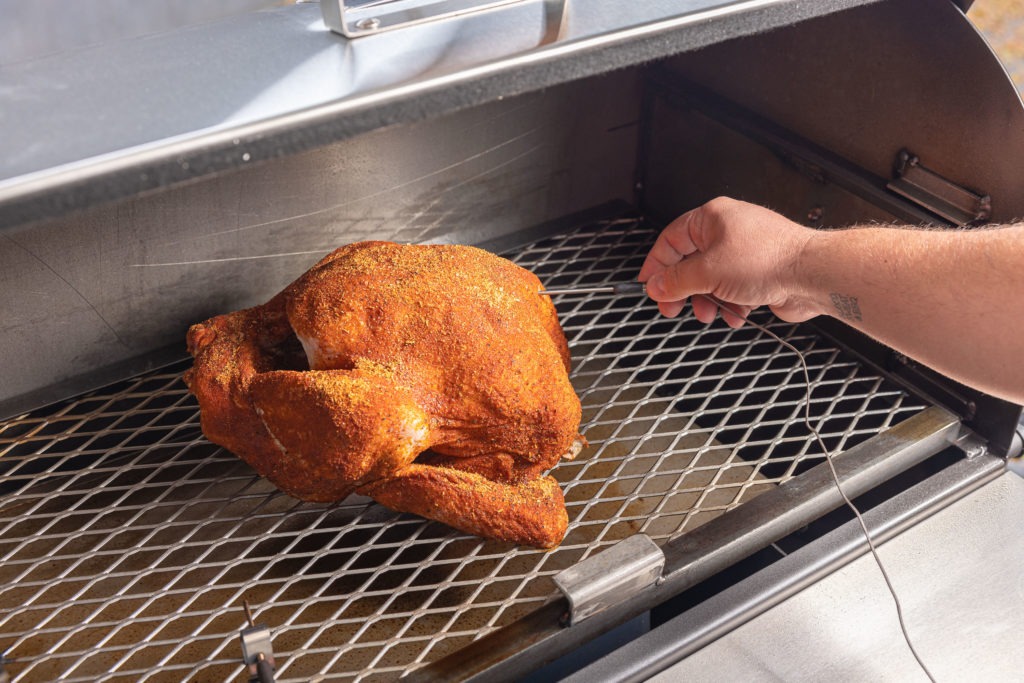
Set the high-alarm for the breast-meat channel to 150°F (66°C). Set the thigh meat channel to 175°F (79°C).
Have a Thermapen® at the ready to spot-check the turkey at the end of cooking.
Smoking the turkey
Monitor the cooking
Your long-range Smoke X4 receiver will let you monitor the progress of your turkey and your smoker temperature without having to stick by the smoker all day. Its signal is strong enough to reach you anywhere in your house, so you can be in the kitchen making potatoes or in front of the TV cheering your team and still know what temp your turkey is outside.
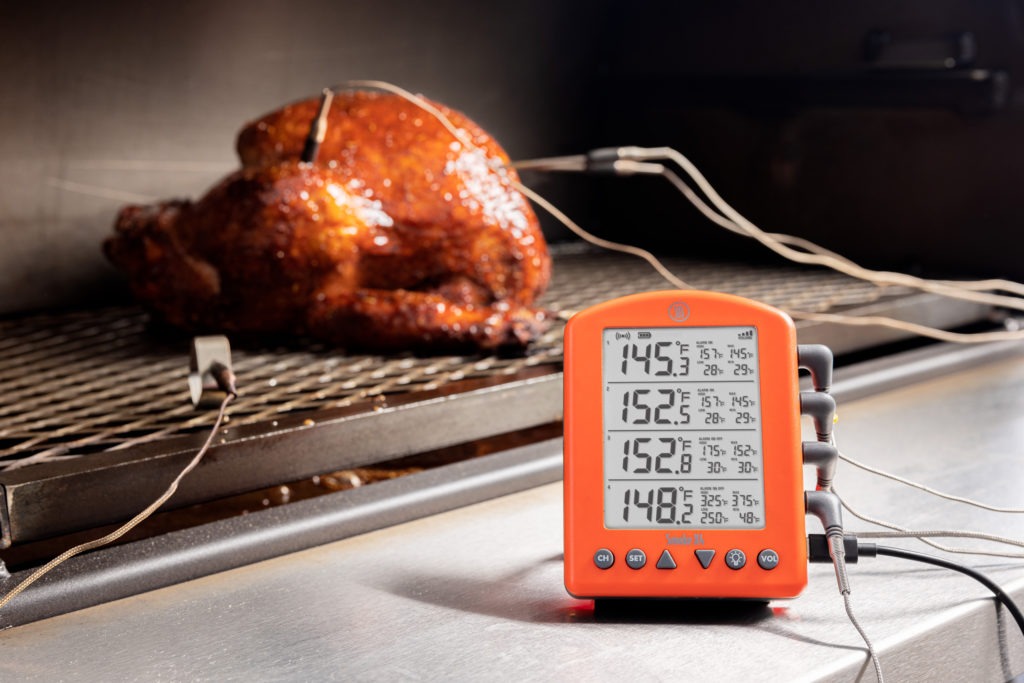
Pull temperature
We set the breast-meat alarm for 150°F (66°C), but that’s not where we’re taking out of the smoker1. That’s the temp at which we’re applying sauce.
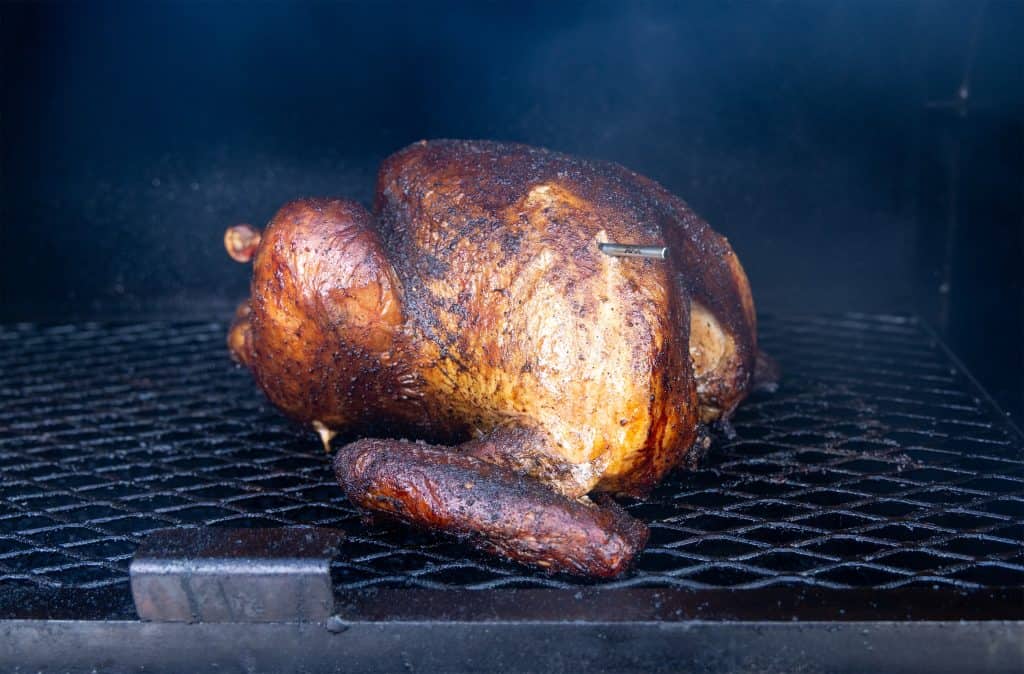
When your Smoke’s meat probe high alarm sounds at 150°F (66°C), brush it with the BBQ sauce of your choice. We used one with a little cranberry in it, which was obviously tasty. Now increase the temp in your smoker to 325°F (163°C) to set the sauce and make it sticky, and increase the temperature alarm on your Smoke X4 to 157°F (69°C)—that is our pull temp.
When the high-temp alarm sounds, check your turkey with a Thermapen® ONE in a few places to be sure it is thoroughly cooked. Make sure the lowest temp you see is 157°F (69°C).
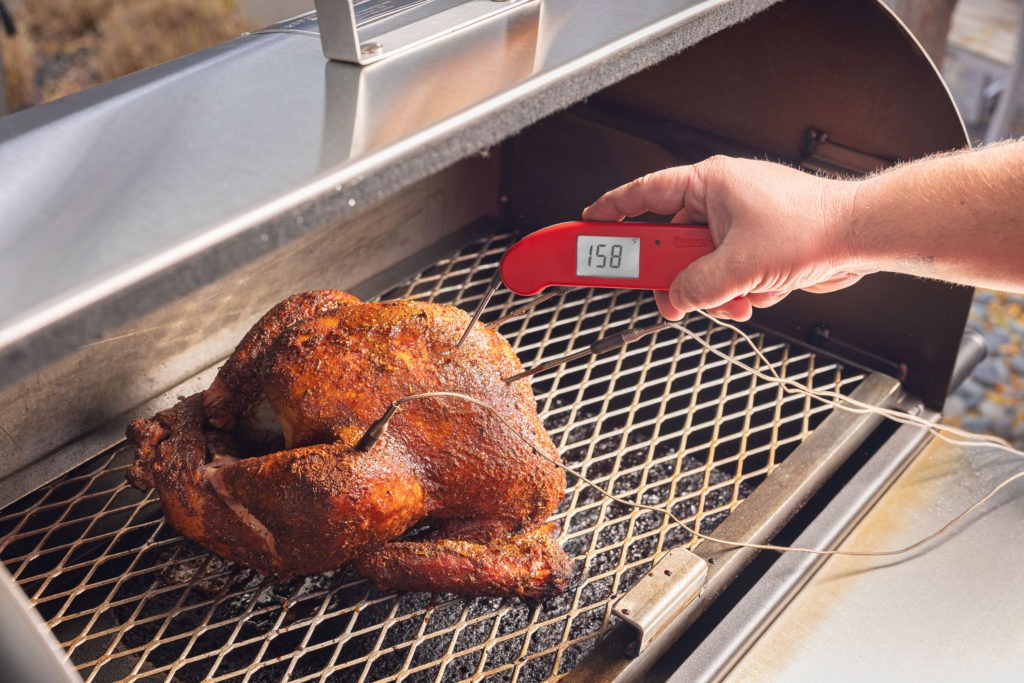
Note: If you see lower temperatures with your Thermapen, either continue smoking and check it again in a little while with your Thermapen OR, using hot mitts, you can reposition your meat probe until it shows a reading similar to the lowest temperature you’re seeing with your Thermapen and wait for the 157°F (69°C) alarm to sound again.
Rest and enjoy
Finally, let your turkey rest at least 20 minutes before slicing and enjoying. That rich smoky flavor is amazing with turkey.
With proper monitoring from Smoke X4 and Thermapen ONE, smoking a turkey for any big family gathering is no more difficult than making barbecue pulled pork. Treat the family to something exciting and different this year!
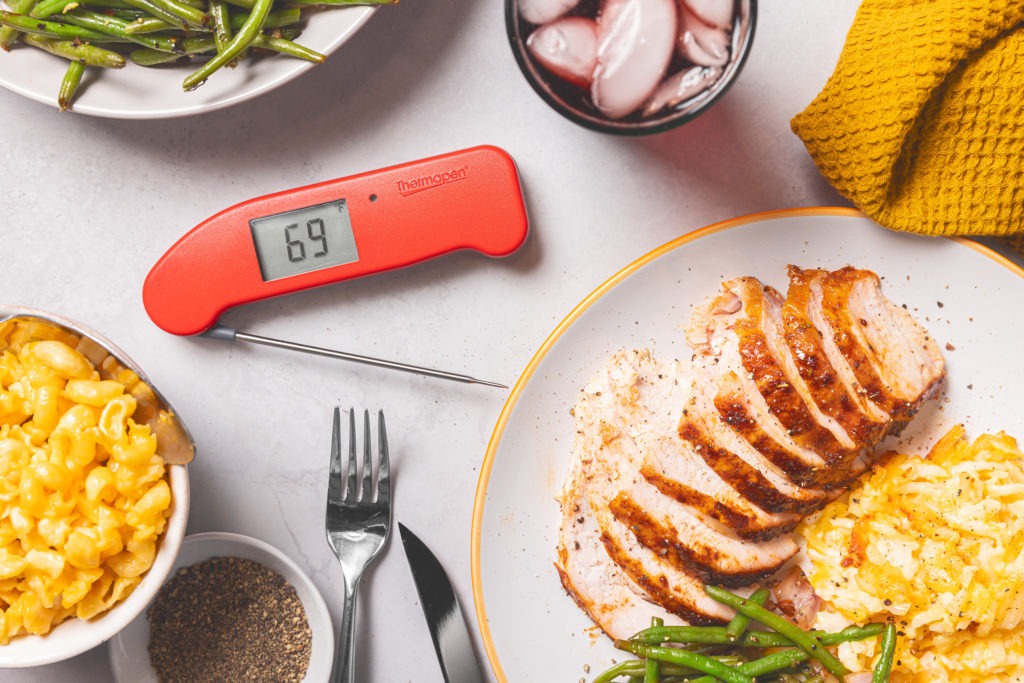
But we could! read about lower pull temps at our post on chicken doneness temps.↩


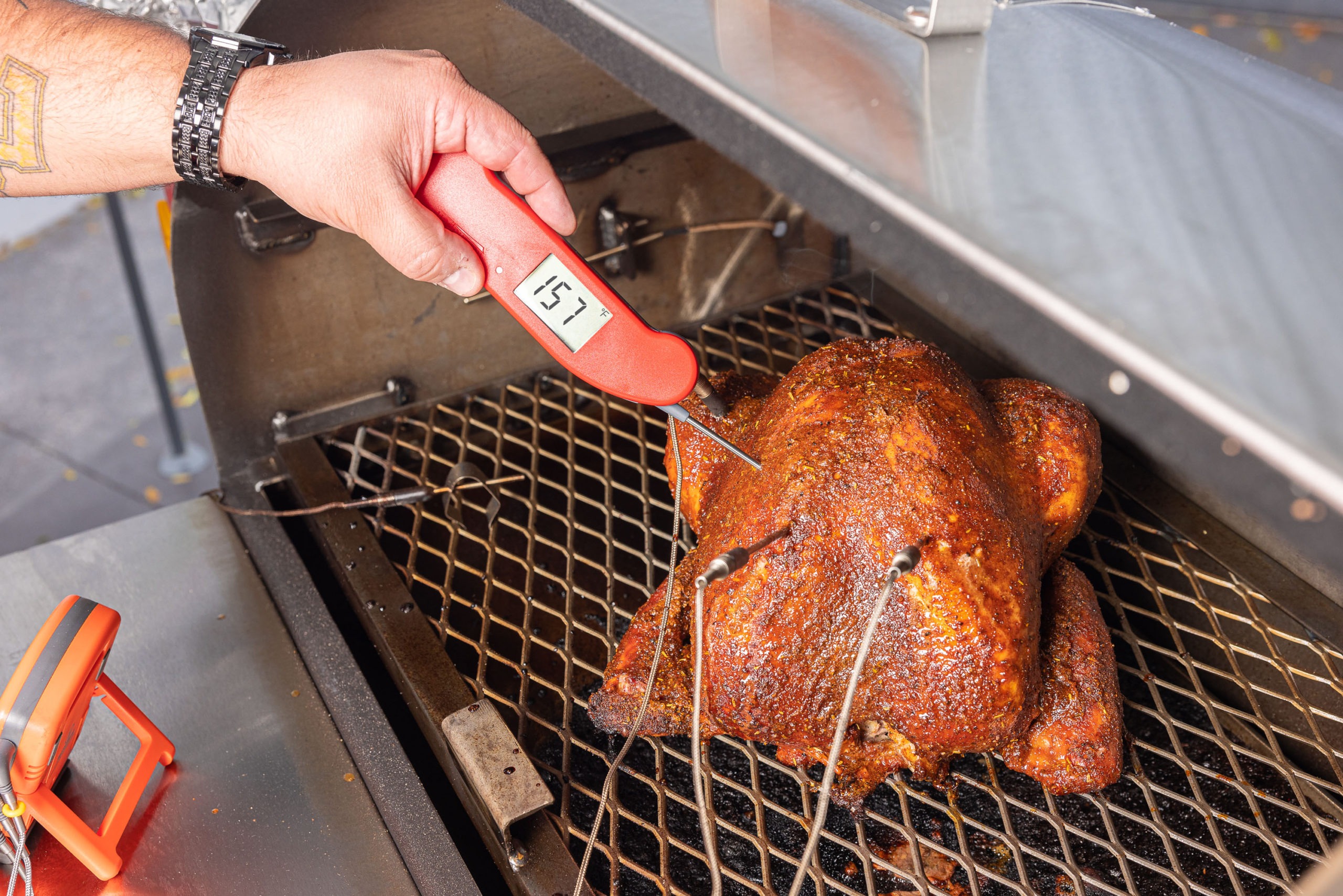
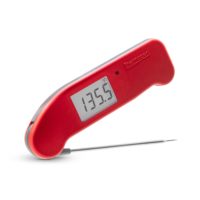
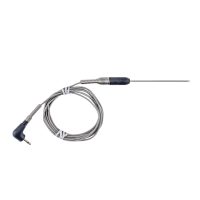
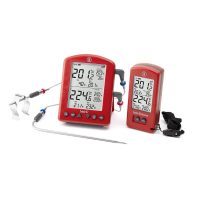
I have been looking for a good yet simple recipe for a turkey on a gas grill and this one seems to be the perfect match for what I am looking for.
I will be looking forward to putting on a Turkey a month from now.
This will save the oven space for the wife to do the pies and muffins and other stuff inside in the oven.
Since I have the Thermoworks Smoke, I will be sitting inside, monitoring the turkey and watching the Vikings beat the Lions while the Turkey is cooking.
Surprised to see you don’t recommend rubbing the turkey with salt (or brining). Why is that?
Joe,
Brining or salting (dry brining) is a great way to make your turkey more tender and moist, and we do recommend salting in some of our other turkey posts. In this case we wanted to focus more on the smoking method than the entire preparation, so we didn’t bring it up. Also we use Butterball turkeys which are pre-injected with a brine, which would make brining redundant for us.
Thanks for the question and I hope this clarifies things. Good luck with your bird!
Hi..great idea this year! As a guide, how long should you plan on to smoke a 20 lb turkey?
Thx so much????
Rachel,
Great question! Take a look at the comment we made above to Mike, and good luck smoking your bird!
Any rough estimates for how long the turkey will take to get to temperature, assuming I follow these instructions, and the turkey is approximately 20lbs?
Thanks,
Mike
Mike,
Timing a bird that size is very important, so this is a great question. I’d plan on something around 12 hours, and that is according to Butterball’s website.
Just make sure you’re also monitoring the temperature the whole time!
Good luck!
approximately how long (per pound) does it take to smoke a turkey using your method?
Bob,
Figuring out how to time the bird so that the pull temp is reached at the right time for dinner is a real problem. There are factors we can’t control or even take into account with each bird. BUT, as a rough guide, go with about 30 minutes per pound. Definitely factor in some error time on that, but it should point you in the right direction.
Good luck!
You say to set the smoker to 250 deg & pull when the internal meat temp reaches 160 deg. I have done this with turkey & chicken & at that temperature the skin in not edible. Before carving the bird I have to remove all the skin. Others have said that to crisp the after smoking, you need to increase the temp in the smoker, put the bird on a hot grill for a few minutes or in an oven, all set at a high temp around 400 deg. Or you can simply pat the skin dry prior to smoking & smoke the bird at around 325 deg until the 160 temp is reached internally. It takes dry hot heat to make the skin crispy. Any comments about this crispy skin problem? I’m curious.
Bill,
You are absolutely correct. The skin right out of the smoker at 250° will be leathery. Moving the bird to a hot oven or grill for 20 minutes or so is a good strategy for crisping the skin, but if you do, be aware that you’re changing the thermal state of the turkey. Lower the temperature you pull the turkey from the smoker by a couple degrees. After the hot-treatment give your bird more time to rest to equalize the temperature gradients. Smoking the turkey at 325° is not very likely to get your skin much crispier than the 250° cook.
Good luck!
When I smoke my turkey after brining, I wrap the turkey with cheese cloth dipped in butter, chicken stock, spices. Then throughout the cooking baste it. Tender skin every time
I agree with James. I soak enough cheese cloth in about 1 lb of melted unsalted butter in a saucepan to wrap the brined turkey completely about two or three times. The turkey is usually about 14 lb or so. The bird will be soaked in buttery wrap, placed in a pellet smoker with a temp probe. I haven’t had to brush butter on during the smoke. The skin comes out nicely crisp. I start smoking plenty early to get the bird done. When the bird is finished, I remove the cheese cloth and wrap it in foil and an old bath towel and put it in a cooler to rest. You can leave it like that in the cooler for hours. Pull it out and carve it just before serving.
Lets get over the confusion about pull temps for turkey. While 160º or 165º will definitely kill anything dangerious in turkey with accurate temperature measurement it is not necessary as this temperature will almost guarantee a dry bird. That is why these temperatures are generally quote as it will result in absolutely no risk as all risks are desabled in 0 seconds. However there is also a published FDA chart of time vs temperature and fat content that shows that a turkey can be properly cooked for safety at 150º or even lower if let at that temperature long enough. Since I cannot include that chart in this reply, Here is the link to it. It is on page 38 of the study:
https://www.fsis.usda.gov/sites/default/files/media_file/2021-12/Appendix-A.pdf
The bottom line of all this is that if you hold the turkey for 5 minutes at a breast temperature of 150º you will have a safe to eat turkey. If you wish to be extra careful, add a minute or two. Note that this is holding time after reaching this temperature that has to be maintained at this minumum for 5 minutes or longer. If you pull the bird when it reaches 150º it may not be safe unless your have already met some of the lower temperature requirements, which may be quite easy to do if you are smoking the bird. Also note that this does require accurate measurement with an accurate thermometer. If you are doing this it is best to test temperature at several places to insure nothing is lower that 150º. If so refer to the chart to insure you have met or exceeded the lower temperature requirements and use the highest fat of 12% time to insure safety as all other readings are shorter times, abet often not much. It also assumes an unstuffed bird as stuffing it can make a major difference and it is now generally recommend that stuffing be cooked separately to insure safety.
Can you give me an idea how long a 10 or 12 pound turkey would take using your method? I need an idea of what time to start the cook. Thanks Dave
Dave,
There are many variables that go into cooking time, including the starting temp of the bird itself, and going by a clock is not likely to result in a perfect bird. That being said, plan at least 4 hours for the cooking time on a bird that size.
Good luck!
I’ve been a home smoker for years and I have smoked pork butt/shoulders, pork ribs, beef briskets, and turkeys. Martin apparently never has because he doesn’t appear to know anything about the correct target internal temperatures for smoking meats.
I guarantee that if you pull a pork butt/shoulder at an IT of 175°F the meat will be inedible. It will be tough with very little of the connective tissue AND fat rendered. I’ve saw this same IT recommended by a poster on a home cooks message board and they were wrong as well. If you’re cooking a pork shoulder with the intention slicing it, perhaps you can get away with a minimum 195°F but there still might be a little toughness to the meat.
The minimum pull IT for a pork butt/shoulder (same cut of meat, different terms) is 199°F. I prefer it to rise to 202°–and the pork meat is never dry, even after resting. Smoking a pork butt/shoulder is really no different from smoking a beef brisket because the same issues apply: both need to be cooked low and slow to an IT of at least 200°F to render all that connective tissue and fat down so the roast comes out juicy and tender.
As for the turkey, the writer displays the same lack of knowledge. Perhaps the writer advises pulling the turkey at an IT of 160°F believing the carryover will raise it to 165°F–which the FDA recommends. I’ve never see than happen although theoretically it is possible.
I do agree with the recommended smoking temp of 250°F is fine. With the high/low air temps, I think setting the high temp alarm at 275°F is too high; 265°F would be sufficient.
One final thought on smoking a turkey: despite what the photo shows of the final turkey result, smoking at a temp of 250°F is not likely to result in browned crispy skin. The skin might be browned but it will most likely be flabby and fatty. What many of us home smokers prefer to do is smoke the turkey until it’s just under the finish IT and then transfer it to a kitchen oven preheated to 450-500°F for about 20-30 minutes (depending on where that IT is) to both fully brown and crisp the skin.
I own one of your thermometers and overall I think your recipe articles are well-written. But in this case, whoever wrote this not only gave out bad information, in the case of the turkey it could be dangerously wrong information.
Rick,
Thank you for your careful and thoughtful reply. I’m sorry if you felt the post was inaccurate. I’m anxious to respond directly to your concerns and see if you have any follow up questions. Please see my replies to your three comments below:
1. smoked pork butt to 175°F
You are absolutely correct that pork shoulder should be cooked to 195°F or higher (as we recommend in our smoked pulled pork post). I meant to suggest that the collagen in the pork shoulder does not BEGIN to break down until the butt reaches 175°F, but I agree that it was misleading and I have corrected the post to read 195°F thanks to your helpful comment.
2. smoked turkey to 160°F
You are also correct about the lack of carryover cooking when smoking a turkey “low and slow.” You should not expect to see much additional rise in temperature after the turkey is pulled from the smoker. 165°F is the USDA-recommended temperature for turkey for an instantaneous 7-log reduction in pathogens. However, the USDA also clearly states that turkey held at 160°F for 16.9 seconds or longer will achieve the same reduction (depending upon the fat content of the turkey). Smoked turkey cooked to 160°F will certainly hold at that temperature for much longer than 17 seconds as the temperature increases so slowly. You can view those USDA turkey “pasteurization” tables here.. You can also read more about the pasteurization of poultry in our baked chicken post.
3. skin not crispy at 250°F smoker temperature
Your recommendation to crisp the skin at a higher temperature in the oven is a great idea and one that we frequently recommend. If you were to do that, I would lower the pull temp even a little further to make sure the meat doesn’t dry out in that final stage of cooking.
Thanks for your comments and happy smoking!
What temperature would you recommend pulling the Turkey off the smoker if you were to put it in the oven for 20-30 minutes @ 400-450? Never done this way before would like to try it.
Steve,
Good question. If you’re planning on crisping it or that long, I’d probably pull it at about 140°-145°. And then pull it from the oven at 157°F. The blast of heat will provide more carryover than the smoker.
Be sure to keep an eye on the temp while it’s in the oven, though! There are some tricky thermodynamics at play when you take the turkey off the heat, move it through cold air and then put in ta higher heat, but that’s the whole point of a good leave-in thermometer isn’t it!
Good luck!
What difference , if any, will using a convection oven make crisping the skin?
Thanks
It can certainly help, but be sure to use a slightly lower temp, as the convection amplifies the effect of the temperature. Knock 25°F off your convection temp.
Wish this article was also converted to a recipe format rather than just prose. Also, no mention of estimated cook times. Otherwise, rather tempting!
Nestor,
It should take about 3-4 hours, depending on turkey size and initial temps.
If you have a gas grill that has 2 burners, so that you can control each side, put the bird on one side of your grill with a big 2 1/2″ deep disposable aluminum pan under it filled with water.
Remove the grill grate on the other side and put your smoker chips box full of soaked wood chips on the ceramic disks or flavor bars or what have you on the other side and light that side of the grill.
Close the lid and adjust your temperature to whatever method temp you want to use. I use 325°. The heat not being under the bird makes the grill circulate like a convection oven and carry the smoke all around the bird and the water boils a little and raises the humidity to keep things moist. Later the drippings in the water pan are the base for your gravy.
My grill perfectly cooks a 14lb. bird in around 2 1/2 hours with frequent openings to put in more wood chips. Have done it this way for 30 years, few complaints.
Cooking a turkey via indirect method plan on 11 minutes per pound; I have been doing this for over 40 years and the bird comes out fully cooked with crisp skin
This seems to be what I’m finding as well, but everything else seems to say 30 mins a pound at 250. Two years in a row and I’m hours early. What’s up with that? Are you and I just smoking in an alternate universe?
I was just looking through your “Free Turkey Guide,” and for the dry brining approach (page 5), there is no mention of how much kosher salt per pound of bird? So, how much? I’ve been dry-brining steaks for years but never dry-brined a turkey, so I am interested in trying this.
Going by the pound is difficult to say. We’ve never weighed the salt we’ve applied. Coating the surface well, but not opaquely, with Diamond Crystal salt is our go-to method.